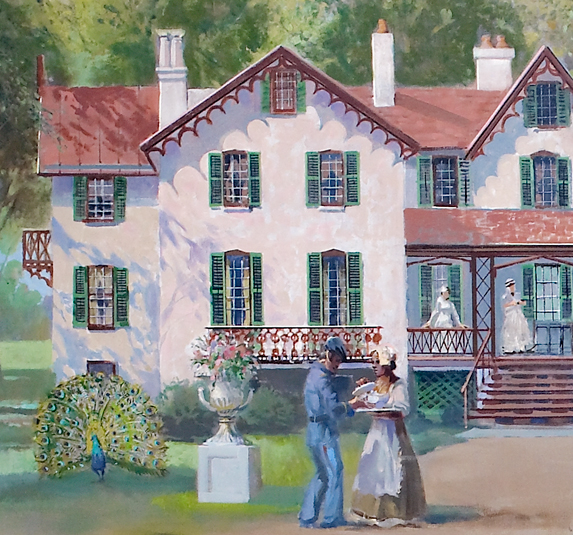By Sahand Miraminy
The Soldiers’ Home continues a tradition of abundant vegetable gardens on the grounds today. These gardens are a testament to the Home’s history of self-sustainability. The success of these gardens may be due to the well nourished soil which rests on the footprint of a very successful yet forgotten cattle operation on the property. For over 100 years, the Soldiers’ Home was home to herds of cattle. The first three cattle were purchased from George Riggs; the builder of the Gothic Revival home that Lincoln would later use as a summer residence. Over the years, the number of cattle multiplied to several hundred. These prized herds were known for their vitality and a successful dairy business, which included the production of butter and buttermilk, followed soon after. Redevelopment ultimately ended this once significant feature of the landscape. Sights, sounds, and smells of rural landscapes, as well as accessibility to fresh foods, were probably often witnessed by Lincoln and those who travelled to the Soldiers’ Home.
 The subject of Lincoln’s appetite still fascinates many just as it did 150 years ago. Descriptions of the President’s habits range from those who described him as a man with a hearty appetite to those, such as White House aide John Hay, who described his lunch as “a biscuit, a glass of milk in winter, some fruit or grapes in summer.” It is widely accepted that President Lincoln enjoyed simple fare like apples and other fruits. “Mrs. Lincoln always had a sufficiency of this fruit chosen carefully and ready at hand,” recalled White House guard William Crook. As a wartime President, it is probable that Lincoln oftentimes ate on-the-go, had loss of appetite due to stress, or, according to some accounts, even forget to have some meals. A cook, sometimes called Aunt Mary, was one individual working at the cottage during the Lincoln’s residence. She was one of several African American staff members tending to the First Family who were free and paid. Aunt Mary apparently became a favorite of the soldiers that guarded the family at the cottage with her gracious culinary offerings of biscuits and coffee in the morning.
The subject of Lincoln’s appetite still fascinates many just as it did 150 years ago. Descriptions of the President’s habits range from those who described him as a man with a hearty appetite to those, such as White House aide John Hay, who described his lunch as “a biscuit, a glass of milk in winter, some fruit or grapes in summer.” It is widely accepted that President Lincoln enjoyed simple fare like apples and other fruits. “Mrs. Lincoln always had a sufficiency of this fruit chosen carefully and ready at hand,” recalled White House guard William Crook. As a wartime President, it is probable that Lincoln oftentimes ate on-the-go, had loss of appetite due to stress, or, according to some accounts, even forget to have some meals. A cook, sometimes called Aunt Mary, was one individual working at the cottage during the Lincoln’s residence. She was one of several African American staff members tending to the First Family who were free and paid. Aunt Mary apparently became a favorite of the soldiers that guarded the family at the cottage with her gracious culinary offerings of biscuits and coffee in the morning.
Perhaps one of the most interesting aspects of Lincoln’s appetite is the broad range of foods that he was exposed to during his lifetime. In Lincoln’s Table, author Donna D. McCreary explores the President’s “culinary journey from cabin to cosmopolitan” where “his tasty morsels changed from wild game and cornbread prepared on an open fire to chef-inspired dishes sculptured to resemble baskets and military forts”. This gave Lincoln diverse exposure to so-called favorites such as fricasseed chicken, corncakes, pecan pie, oysters, and gingerbread to name a few. Through the usage of historic accounts, family recipes, and period fare, Donna D. McCreary gives readers a peek at Lincoln’s table.
Lincoln’s Table: A President’s Culinary Journey from Cabin to Cosmopolitan is available in the President Lincoln’s Cottage Museum Store at the Robert H. Smith Visitor Education Center. All proceeds aid in the preservation of the site.
Image: Aunt Mary became a favorite with the soldiers at the Cottage. (detail of mural by William Woodward)
